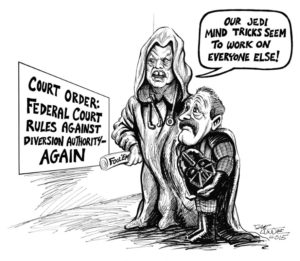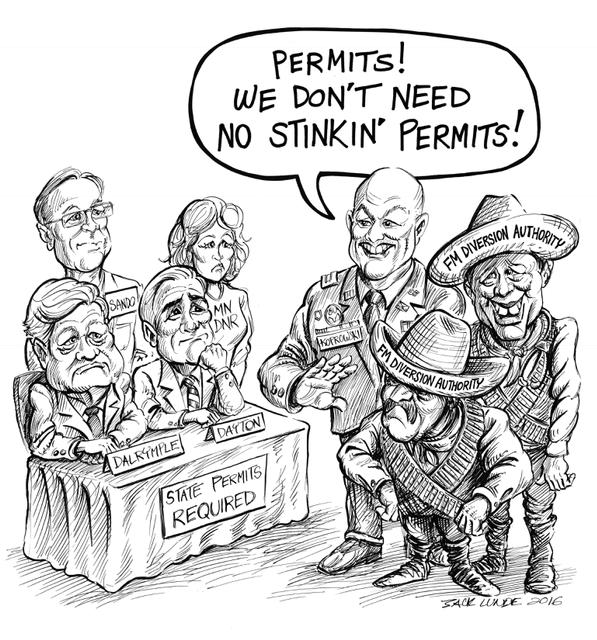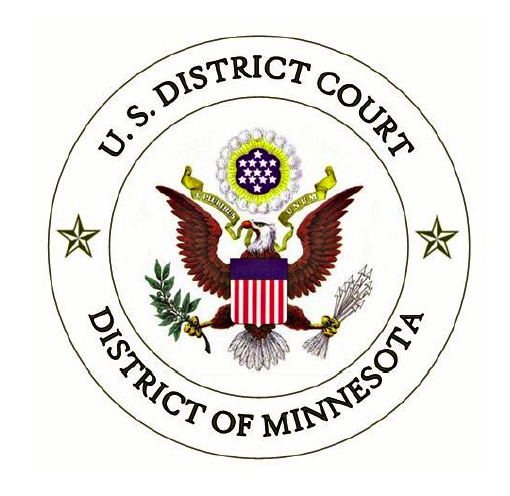In an ongoing effort to help property owners affected and impacted by the Fargo Dam and FM Diversion project, FMDam.org reached out to Attorney Al Baker, ElawPros.com for insight as to the significance of a recent ND Supreme Court Decision.
If you have received letters -or- coercive pressure from the FMDA regarding easements or the threat of eminent domain, you owe it to yourself to contact Al Baker 701-630-1846 to ensure your property rights are preserved.
In a strongly worded decision intended to protect property owners from the injury and damage caused by the Cass County Joint Water Resource District (CCJWRD) the North Dakota Supreme Court has stated:
| “PLACEMENT OF SURVEY MONUMENTS ON THE LANDOWNERS’ PROPERTIES FOR AS LONG AS THREE YEARS IS NOT AN ‘INNOCUOUS ENTRY’ AND WOULD SERIOUSLY IMPINGE UPON OR IMPAIR THE RIGHTS OF THE LANDOWNERS TO THE USE AND ENJOYMENT OF THEIR PROPERTIES.” |
In its March 24, 2021 decision in Cass County Joint Water Resource District v. Aaland et al., 2021 ND 57, the North Dakota Supreme Court reversed a district court decision that allowed the CCJWRD to conducting examinations, surveys and mapping, that included the placement of permanent survey monuments for bathometric surveys, under a North Dakota statute that allows entry onto property to conduct preliminary examinations before starting formal condemnation proceedings. The decision can be found on the North Dakota Supreme Court’s website at:
https://www.ndcourts.gov/supreme-court/opinion/2021ND57
In 2017 the CCJWRD obtained a permit from the Richland County District Court under N.D.C.C. § 32-15-06 to conduct examinations and mapping for the FM diversion project. The permit included the “installation of survey monuments.” The permit was granted in August 2017 and allowed access to property through December 2018. In 2019 the CCJWRD began to obtain easements from landowners to allow long-term access to property. When the CCJWRD failed to obtain easements from property owners it applied for a second permit to conduct examinations. The district court granted the second permit in May 2020 allowing CCJWRD access to property until December 2021.
The North Dakota Supreme Court, in protecting the private property rights of North Dakota citizens, relied on the United States Supreme Court decision in Loreto v. Teleprompter Manhattan CATV Corp.
The North Dakota Supreme Court held that when a government agency permanently occupies property, it effectively destroys the property owners’ rights to possess, use and dispose of the property. The government’s permanent occupation of the property destroys the landowner’s right to exclude non-owners from possession and use of the property. The landowner’s power to exclude other from the property “has traditionally been considered one of the most treasured strands in an owner’s bundle of property rights.” Also, permanent physical occupation of the property “forever denies the owner any power to control the use of the property.”
The North Dakota Supreme Court reversed the district court’s May 2020 order allowing the CCJWRD a right of entry onto property to place permanent survey monuments and conduct bathometric surveys and also remanded the case back to the district court to consider the landowners’ request for an award on attorney’s fees and cost under N.D.C.C. § 32-15-32.
There is no doubt that landowners can successfully fight and prevail against the CCJWRD’s willingness to trample on the well established property rights of landowners being injured by CCJWRD’s unrelenting misuse of government power to do the bidding of the Fargo Flood Diversion Project.
| – Here is the ND Supreme Court Decision – |
PDF Download Decision 2021ND57 – ( 706 kb )
|
FILED |
|||
|
IN THE SUPREME COURT |
|||
|
|
|||
| 2021 ND 57 | |||
|
|
|||
| Cass County Joint Water Resource District, | Plaintiff and Appellee |
| v. | |
| Cash H. Aaland, Larry W. Bakko and Penny Cirks, |
Defendants and Appellants |
| and | |
| Richard and Sandra Ihland, Stuart D. Boyer and Patricia J. Boyer, Vance G. Gylland, Thomas Jorgensen, Brent Larson and Timothy Larson, Mary Jo Schmid, Thomas R. Nelson and Michelle Nelson, Jeffrey C. Shipley and Maria Shipley, Patricia A. Rudnick, Dona L. Duffy, Myron Ihland, Carol Sheridan, Marjorie Rieger, Betty Jean Hulne (deceased), Gregory S. Hulne, Jack T. Hulne, Michael J. Hulne, David A. Hulne, Jean M. Johnson, Dorothy A. Stapleton and Laura Aaland, |
Defendants |
|
|
|||
| No. 20200171 | |||
|
|
|||
Appeal from the District Court of Richland County, Southeast Judicial District,
the Honorable John A. Thelen, Judge.
REVERSED AND REMANDED.
Opinion of the Court by Tufte, Justice.
Rob A. Stefonowicz, Minneapolis, Minnesota, for plaintiff and appellee.
Jennifer A. Braun, Fargo, North Dakota, for defendants and appellants.
Cass County Joint Water Resource District v. Aaland
No. 20200171
Tufte, Justice.
[¶1] Cash Aaland, Larry Bakko, and Penny Cirks (the “Landowners”) appeal from orders granting the Cass County Joint Water Resource District (the “District”) a right of entry onto their properties to conduct surveys and examinations related to the Fargo-Moorhead Flood Diversion Project. The Landowners argue these surveys and examinations are beyond the scope of N.D.C.C. § 32-15-06. We reverse, concluding the District’s right of entry exceeds the limited testing permitted under N.D.C.C. § 32-15-06, and remand for a determination on attorney’s fees and costs.
I
[¶2] In April 2017, the District applied for a permit to enter certain lands, including the Landowners’ properties, to conduct examinations, surveys, and mapping for the evaluation and design of a proposed flood control project in the Fargo-Moorhead metropolitan area. One such examination was a geomorphic examination requiring the installation of survey monuments on the properties. In August 2017, the district court granted the application and allowed the District entry onto the Landowners’ properties through December 2018.
[¶3] In 2019, the District contacted the Landowners seeking to purchase easements on their properties to conduct long-term monitoring for the Fargo-Moorhead flood diversion project. After the District failed to obtain these easements, it applied for a second permit to enter the Landowners’ properties to monitor environmental impacts in connection with the project through December 2021. The application provides that access to the Landowners’ properties is once again necessary to conduct examinations, surveys, and mapping, including geomorphic examinations requiring installation of survey monuments on certain properties. The Landowners opposed the District’s application. In May 2020, following two hearings, the district court granted the application, allowing the District entry on the Landowners’ properties through December 2021.
II
[¶4] The Landowners argue the district court erred by granting the District a right of entry onto their properties under N.D.C.C. § 32-15-06. Statutory interpretation is a question of law, which is fully reviewable on appeal. Minnkota Power Coop., Inc. v. Anderson, 2012 ND 105, ¶ 6, 817 N.W.2d 325. The primary objective in interpreting a statute is to determine the legislature’s intended meaning from the language of the statute. Id. “Words in a statute are to be given their ordinary and commonly understood meaning unless defined by statute or a contrary intention is clearly evident.” Id. (citing N.D.C.C. § 1-02-02).
[¶5] Section 32-15-06, N.D.C.C., provides:
|
“[A] proceeding for a court order authorizing examinations and surveys under N.D.C.C. § 32-15-06 is ‘preliminary to the condemnation action itself’ and is not a condemnation proceeding.” Alliance Pipeline L.P. v. Smith, 2013 ND 117, ¶ 15, 833 N.W.2d 464 (quoting Square Butte Elec. Coop. v. Dohn, 219 N.W.2d 877, 883 (N.D. 1974)).
[¶6] The Landowners contend the District’s 2020 right of entry onto their properties goes beyond making examinations, surveys, and maps permitted by N.D.C.C. § 32-15-06.
[¶7] In Square Butte Electric Cooperative v. Dohn, the district court granted an electric cooperative permission under N.D.C.C. § 32-15-06 to enter lands for the purpose of making surveys, including soil testing and ground resistance measurements. 219 N.W.2d 877, 879 (N.D. 1974). The surveys and testing were necessary to determine the route of a planned electrical line. Id. at 884. This Court affirmed, holding, in relevant part, the electric cooperative “established a sufficient basis for an appropriate order permitting such a survey and limited testing under reasonable conditions and with reasonable protection to the landowner.” Id.
[¶8] In 2016, this Court reviewed the meaning of “examinations” as it appears in N.D.C.C. § 32-15-06. See In re 2015 Application for Permit to Enter Land for Surveys and Examination Associated with a Proposed North Dakota Diversion and Associated Structures, 2016 ND 165, 883 N.W.2d 844. In In re 2015 Application, this Court held the District’s soil borings test was an examination under N.D.C.C. § 32-15-06. 2016 ND 165, ¶ 14. The soil borings removed one to two pints of soil for testing, and the District was required to pay $250 for each hole bored and to fill in the hole after testing. Id. at ¶ 9. We concluded, “Although the proposed soil borings penetrate the ground’s surface, the testing is nevertheless minimally invasive, or ‘limited.’” Id. at ¶ 14 (citing Square Butte, 219 N.W.2d at 883).
[¶9] Before 1963, California had a statute nearly identical to N.D.C.C. § 32-15-06, authorizing state agents to enter private land required for public use to “make examinations, surveys and maps thereof.” See Prop. Reserve, Inc. v. Superior Court, 375 P.3d 887, 901 (Cal. 2016) (quoting Cal. Civ. Proc. Code § 1242 (amended 1963 and 1970; repealed 1975)). Section 32-15-06, N.D.C.C., is derived from Cal. Civ. Proc. Code § 1242. See City of Grafton v. St. Paul M. & M. Ry., 113 N.W. 598, 599 (N.D. 1907) (stating our eminent domain statute, chapter 36 of the Code of Civil Procedure (Rev. Codes 1905), “was, no doubt, borrowed from” California); N.D.R.C. § 7579 (1905) (identifying the former N.D.C.C. § 32-15-06 as a part of the eminent domain statute in the Code of Civil Procedure). In construing Cal. Civ. Proc. Code § 1242, the Supreme Court of California concluded that it permitted only “such innocuous entry and superficial examination as would suffice for the making of surveys or maps and as would not in the nature of things seriously impinge upon or impair the rights of the owner to the use and enjoyment of his property.” Jacobsen v. Superior Court of Sonoma County, 219 P. 986, 991 (Cal. 1923), superseded by statute, Cal. Civ. Proc. Code §§ 1245.010-1245.060, as recognized in Prop. Reserve, 375 P.3d at 905. [1 see footnote] Because N.D.C.C. § 32-15-06 is derived from, and nearly identical to, California’s prior statute, Cal. Civ. Proc. Code § 1242, the Supreme Court of California’s construction of Cal. Civ. Proc. Code § 1242 in Jacobsen is particularly persuasive to this Court. Estate of Zins v. Zins, 420 N.W.2d 729, 731 (N.D. 1988) (“While we are not compelled to interpret our statute in the same way as the State from which our law is derived, such decisions are highly persuasive.”).
[¶10] On August 15, 2017, the district court granted the District entry to the Landowners’ properties through December 2018. For sixteen and one-half months this order granting right of entry gave the District access to the land to make examinations, surveys, and maps thereof. As a part of the 2017 order, the District was allowed to perform geomorphic examinations, which required the installation of survey monuments on the properties. The District conceded at oral argument that these monuments were in fact installed pursuant to the 2017 order.
[¶11] After the 2017 order expired and the District had failed to obtain easements from the Landowners, it applied for a second order permitting entry on the Landowners’ properties to further monitor environmental impacts in connection with the Fargo-Moorhead flood diversion project. In orders dated May 12, 2020, as amended on May 13, 2020, and May 29, 2020, the district court granted the District permission to enter the Landowners’ properties through December 2021. Accordingly, the District was given at least an additional nineteen months to once again make examinations, surveys, and maps of the land, including the use of survey monuments. Upon expiration of the 2020 orders, the District will have had access to the Landowners’ properties for approximately thirty-five and one-half months.
[¶12] The District’s application states it must install permanent survey monuments on the properties:
|
[¶13] The placement of survey monuments are unlike the limited soil testing and ground resistance measurements in Square Butte and unlike the soil borings test in In re 2015 Application. In In re 2015 Application, the District’s application provided it “must bore a limited number of holes on certain properties to obtain subsurface soil samples.” 2016 ND 165, ¶ 9. Here, the District was permitted to install its survey monuments for almost three years. The Supreme Court of the United States has described the harm presented by a permanent physical occupation:
|
Loretto v. Teleprompter Manhattan CATV Corp., 458 U.S. 419, 435-36 (1982) (cleaned up).
[¶14] Section 32-15-06, N.D.C.C., permits entry upon the land to make examinations, surveys, and maps thereof, which is “preliminary to the condemnation action itself.” Alliance Pipeline, 2013 ND 117, ¶ 15. Under the 2017 order, the District was afforded sixteen and one-half months to perform its examinations and surveys. Placement of survey monuments on the Landowners’ properties for as long as three years is not an “innocuous entry” and would seriously impinge upon or impair the rights of the Landowners to the use and enjoyment of their properties. See Jacobsen, 219 P. at 991. A physical occupation of this duration goes beyond the minimally invasive examination and testing permitted under N.D.C.C. § 32-15-06. Accordingly, we reverse the district court’s May 2020 orders granting the District a right of entry onto the Landowners’ properties.
III
[¶15] The Landowners request attorney’s fees and costs under N.D.C.C. § 32-15-32, which provides in relevant part:
|
The district court did not rule on the issue. Therefore, we remand for a determination of whether the Landowners are entitled to attorney’s fees and costs under N.D.C.C. § 32-15-32.
IV
[¶16] We reverse the district court’s May 13, 2020 and May 29, 2020 orders granting the District a right of entry onto the Landowners’ properties, and remand for a determination on attorney’s fees and costs.
| [¶17] | Jon J. Jensen, C.J. Gerald W. VandeWalle Daniel J. Crothers Lisa Fair McEvers Jerod E. Tufte |
[1] California has since expanded the scope of activities permitted in its pre-condemnation entry statute, see Cal. Civ. Proc. Code § 1245.010, and the protections provided to the landowner, see Cal. Civ. Proc. Code §§ 1245.020-1245.060. Unlike California, North Dakota has not expanded the scope of activities permitted or the protections afforded to landowners under N.D.C.C. § 32-15-06.
Views: 1514



Property owners have rights! Stay informed. Don’t just give in to the Diversion Authority!